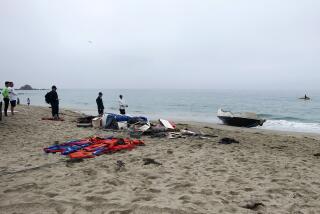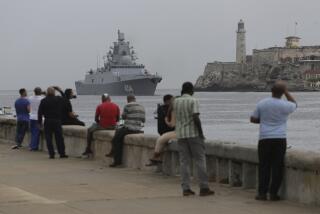Cubans Attempt a Bumpy Ocean Drive
- Share via
MIAMI — The radio call must have raised more than one eyebrow. There was nothing surprising about yet more Cubans trying to cross the water from their communist-ruled island to the Florida coast, and freedom. But these 12 were using a vintage Chevy truck.
To reach U.S. shores, desperate Cubans have windsurfed, floated in rubber inner tubes and used frail handmade boats and rafts, including a catamaran fashioned from melted Styrofoam cups. Some have even hijacked airplanes or ships. But until last week, no one had chanced the 90-mile passage across the treacherous, shark-infested Florida Straits in a motor vehicle.
According to the Coast Guard, the green 1951 flatbed Chevrolet had been converted to seagoing use by attaching a buoyant pontoon of 55-gallon drums. A propeller had been stuck to the end of the drive shaft.
Photos of the unlikely vessel were splashed on the front pages of Florida newspapers Thursday and footage aired on TV news.
Some Floridians marveled at its creators’ ingenuity. “It was like seeing a sea serpent riding up and down on the waves,” said Holly Ackerman, an assistant professor at the University of Miami and author of a book on the Cuban balseros, or rafters.
“I’ve seen some pretty unusual conveyances used to cross from Cuba, but never a truck,” said Cameron Hintzen, resident agent in charge of the U.S. Border Patrol in the Florida Keys.
The Chevy still had its tires intact, Hintzen said, perhaps because the passengers intended to drive up onto the beach once they landed in Florida.
The truck, with a dozen would-be migrants on board, was sighted on July 16 about 40 miles south of Key West, tooling through the waves at 7 knots (8 mph) with a driver at the wheel, Coast Guard Petty Officer Carleen Drummond said Thursday. Its position meant the truck had cruised at least 50 miles on the high seas, she said.
The craft was spotted by a patrol plane from the Bureau of Immigration and Customs Enforcement, which radioed news of the discovery to the Coast Guard, officials said. The 110-foot cutter Key Largo and a smaller vessel from the Coast Guard station in Key West were dispatched to the scene.
The people on the truck were taken off by the Coast Guard, their vessel scuttled as a potential hazard to navigation, Drummond said.
“You just can’t leave a random boat out there floating around,” said Drummond, a spokeswoman at Coast Guard district headquarters in Miami.
For the 12 seafarers, however, the voyage was for naught. On Sunday, they were repatriated to Bahia de Cabanas, Cuba, under what is known as the “wet-foot, dry-foot” policy on Cuban immigration. In general, Cubans intercepted at sea are returned to the island, while those who make it to U.S. soil are permitted to stay.
These days, more Cubans are risking their lives to flee their homeland, where the state-run economy is in crisis and Fidel Castro’s regime has been cracking down on dissent. Last fiscal year, the Coast Guard intercepted 666 Cubans at sea; since October, the number interdicted has jumped to 1,178, said Coast Guard Petty Officer Ryan Doss in Miami.
“One has to think of what is behind these escapes, the amount of frustration,” said Juan Clark, professor of sociology at Miami-Dade Community College. “One has to remember that historically, one out of three rafters has made it to freedom. The rest were captured or died in the attempt.”
Clark said his son used to go fishing in the Keys, “and would come across remnants of rafts, sometimes with bones next to them.”
Ackerman estimated that since 1964, “at least 16,000 of them -- that is a low figure -- died at sea.” The rafters’ experience, she said, “has been a massive human tragedy.”
Ackerman called the converted truck “one of the cleverest rafts for sure,” and said she was saddened its passengers hadn’t been successful in their gamble to reach the United States.
“The poor people lost,” she said. “It breaks our heart.”
Clark predicted the returnees would be given a “hard time” by Cuban authorities, but Ackerman disagreed. “No harm should come to them,” she said, pointing out that a Cuban American agreement allows U.S. diplomats posted in Havana to monitor their treatment.
Concern about the Cubans’ fate was heightened because of the harsh treatment meted out by authorities on the island to three men who tried to hijack a Havana ferry and sail it to Florida in April. They were shot by a firing squad after a speedy trial.
On Monday, the Coast Guard returned 11 Cuban men and one woman who had commandeered another boat after the government in Havana pledged not to execute them. The 12 had commandeered the 36-foot Gaviota 16, a Cuban government marine mapping vessel, in the northeastern port of Boca de Nuevitas on July 15. The next day, the vessel was halted by the Coast Guard 60 miles from Miami.
U.S. officials have said they want to discourage hijackings and other dangerous or illegal attempts to reach the United States. However, the three Cuban American members of Congress from Miami reacted angrily to the government’s decision to return the people who had seized the Gaviota 16.
“This act of infamy in coordination with the Cuban tyranny is a condemnable monstrosity,” Reps. Lincoln Diaz-Balart, Mario Diaz-Balart and Ileana Ros-Lehtinen, all Republicans, said in a statement. “Castro’s Cuba is a place where there are no laws, no independent courts or judicial system, and the entire island is at the whim of a tyrannical despot.”
Cuban state-run media on Tuesday disseminated a statement from James Cason, chief of the American Interests Section in Havana, warning that “Cuban citizens who take to the sea in a mistaken effort to reach the U.S. coast in an illegal and unsafe manner should be aware that our country’s security agents will make every effort to intercept them.”
In the past, human smugglers have done a brisk business transporting Cubans to the United States in speedboats for an estimated $6,000 to $10,000 a head. But Hintzen said authorities have been cracking down on that illegal traffic, which the Border Patrol official said was another reason for an “upswing” in riskier attempts.
*
Times researcher Anna M. Virtue contributed to this report.
More to Read
Sign up for Essential California
The most important California stories and recommendations in your inbox every morning.
You may occasionally receive promotional content from the Los Angeles Times.










